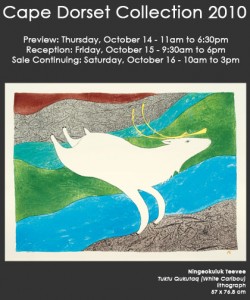Since the 1950s, Cape Dorset or Kinngait, the “Capital of Inuit Art” has been a centre for drawing, printmaking and carving. Today, printmaking and carving are the community’s main economic activities. But some older artists along with younger ones are creating art of a different nature, art that is less known and less valued in southern Canada – art that reflects the artists’ changing social and environmental context. The video “The New Raw” focuses on this situation.
The New Raw
Video 11 min. Radio Canada International (RCI)
Interviews with Cape Dorset artists and footage of their art inform the viewer of the diversity of northern art. The viewer hears that southern Canadian art lovers still seek and maintain the demand for Arctic art with traditional images – the animals of Inuit legends – but there is a growing number of Cape Dorset artists who produce art reflecting the social and environmental change of their day-to-day realities.
http://eyeonthearctic.rcinet.ca/en/video/video-categories/viewvideo/59/art-and-culture/the-new-raw
See also these RCI videos:
The Rebel – Jutai-Toonoo, 26 min.
http://eyeonthearctic.rcinet.ca/en/video/viewvideo/60/art-and-culture/the-rebel-jutai-toonoo
The Up-And-Comer – Ningeokuluk Teevee, 8 min.
http://eyeonthearctic.rcinet.ca/en/video/viewvideo/64/art-and-culture/the-up-and-comer-ningeokuluk-teevee
The Carver – Toonoo Sharky, 8 min.
http://eyeonthearctic.rcinet.ca/en/video/viewvideo/61/art-and-culture/the-carver-toonoo-sharky
The Printer – Niveaksie Quvianaqtuliaq, 7 min.
http://eyeonthearctic.rcinet.ca/en/video/viewvideo/62/art-and-culture/the-printer-niveaksie-quvianaqtuliaq
Note: In this video we see the making of the print of “Stiletto,” an example of a more modern stone cut art piece by Kavavaow Mannomee.
